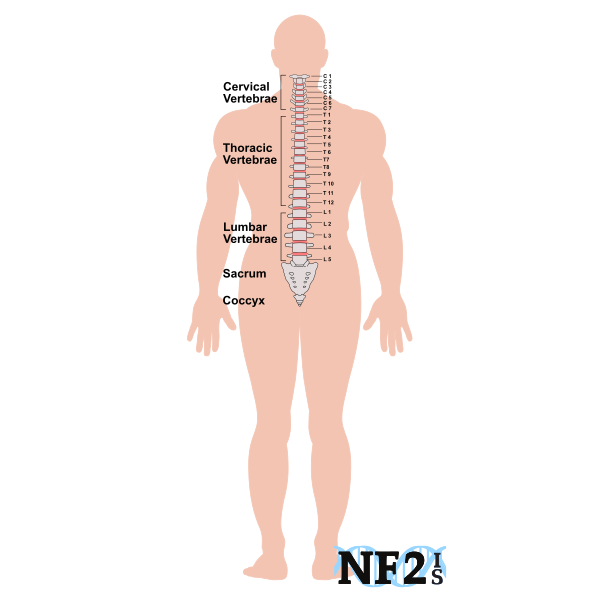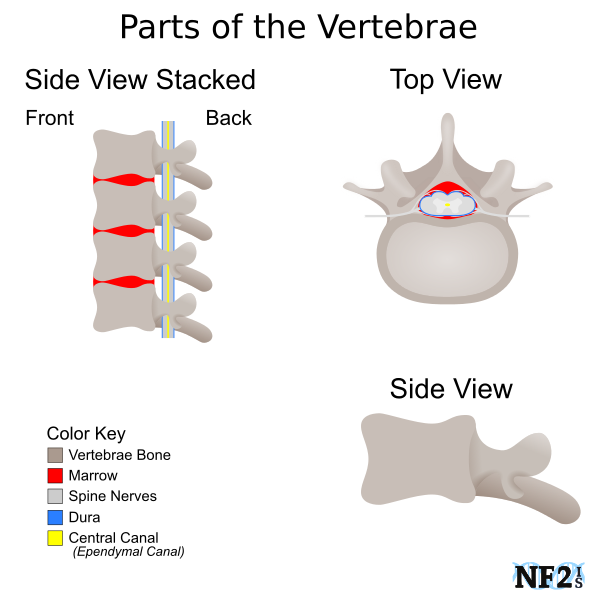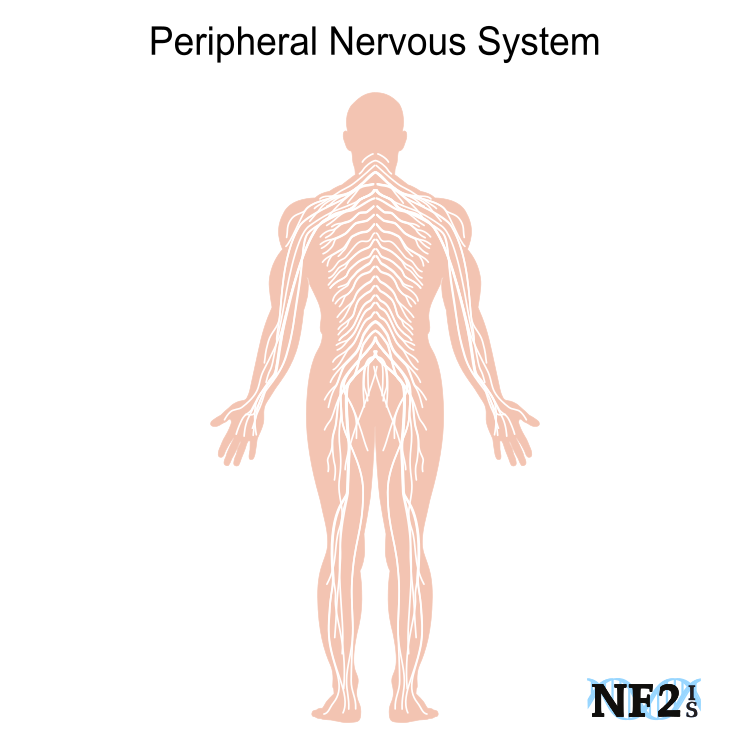Home > NF2 Facts & Information > Damage - Tumors and Schwann Cells > Peripheral Nerve Damage >
Spinal Cord
Last Updated: 01/12/25
Index
- Voluntary Nervous System - Muscles and Movement
- Autonomic Nervous System - Organs
- Spinal Cord Tumors
Also See
- Peripheral Nerve System: Damage
Peripheral Neuropathy - Vitamin B12: Healing Nerve Damage
- Skeletal Abnormalities
Individuals with neurofibromatosis type 2, NF2, are commonly known to develop tumors in the skull. NF2 skull-based tumors are either schwannoma or meningioma. However, it is also common for individuals with NF2 to also develop tumors along the spinal cord tumor types include spine schwannoma and ependymoma.
Some patients with NF2; only develop skull-based tumors, but tumors may grow anywhere in the body, but in the skull and along the spinal cord are the most common locations of growth.
Two types of tumors may grow along the spinal cord; ependymoma and schwannoma.
Tumors in the spine can damage the PNS (Peripheral Nervous System) and depend on how extensive the damage is to the nerves it can result in Spinal Cord Compression. Spinal cord compression is damage to nerves in the spine that will result in issues throughout the Somatic Systems and Autonomic Systems. The Somatic Nervous System is part of the peripheral nervous system, which controls muscles and movement in different parts of the body or voluntary movements. The Autonomic Nervous System affects organs or involuntary movements.
Problems an individual could develop would be are based on the location of the tumor in the spinal cord.
 (View Larger) |
 (View Larger) |
 (View Larger) |
Vertebrae in the spine consist of 33 individual bones, only 24 of which are movable. The vertebrae are categorized as being part of 5 separate regions:
- Cervical Vertebrae: C1 - C7
- Thoracic Vertebrae: T1 - T12
- Lumbar Vertebrae: L1 - L5
- Sacrum: S1 - S5
- Coccyx: 4
1. Voluntary Nervous System - Muscles and Movement
The Voluntary Nervous System, part of the peripheral nervous system. This system controls muscles and movement in different parts of the body.
- Neck - C1, C2, C3, C4, C5, C6, C7
- Diaphragm - C2, C3, C4
- Shoulder to Elbow - C4, C5
- Wrist to Fingers - C6, C7
- Rib Muscles - Trunk, Waist Up - T1, T2, T3, T4
- Abdominal Muscles - T5, T6, T7, T8, T9, T10, T11, T12
- Thigh to Toe - T12, L1, L2, L3, L4, L5
- Sciatic Nerve - L3, L4, L5
- Hip - L5, S1
2. Autonomic Nervous System - Organs
The Autonomic Nervous System (ANS), visceral nervous system, involuntary nervous system, affects organs.
- C1 - Blood Supply the Head, Bones Of The Face, Brain Inner and Middle Ear, Ears, Eyes, Pituitary Gland, Scalp, Sympathetic Nervous System
- C2 - Auditory Nerves, Eyes, Forehead, Heart, Mastoid Bones, Optic Nerves, Sinuses, Tongue
- C3 - Bones, Cheeks, Face, Lungs, Outer Ear, Teeth, Trifacial Nerve
- C4 - Eustachian Tube, Lips, Lungs, Mouth, Mucous Membranes, Nose
- C5 - Neck Glands, Pharynx, Vocal Cords
- C6 - Neck Muscles, Shoulders, Tonsils
- C7- Bursa in the Shoulders, Elbows, Thyroid Gland
- T1 - Arms from the Elbows Down, Arms, Heart, including; Hands, Wrists and Fingers, Esophagus and Trachea
- T2 - Heart, including its Valves and Covering Coronary Arteries; Lungs Bronchial Tubes
- T3 - Breast, Bronchial Tubes, Chest, Heart, Lungs, Pleura
- T4 - Bronchial Tubes, Common Duct, Gallbladder, Heart, Lungs
- T5 - Circulation (general), Esophagus, Heart, Liver, Solar Plexus, Stomach
- T6 - Duodenum, Esophagus, Liver, Peritoneum, Stomach
- T7 - Adrenal Cortex, Appendix, Kidneys, Large Intestine, Ovaries, Pancreas, Spleen, Testes, Uterus
- T8 - Adrenal Cortex, Gallbladder, Liver, Pancreas, Pyloric Valve, Small Intestine, Spleen, Stomach
- T9 - Adrenal Cortex, Gallbladder, Ovaries, Pancreas, Small Intestine, Spleen, Uterus
- T10 - Adrenal Cortex, Appendix, Kidneys, Large Intestine, Ovaries, Pancreas, Spleen, Testes, Uterus
- T11 - Adrenal Cortex, Adrenal Medulla, Ileocecal Valve, Kidneys, Large Intestine, Ovaries, Ureters, Urinary Bladder, Uterus
- T12 - Ileocecal Valve, Kidneys, Large Intestine, Lymph Circulation, Small Intestine, Urinary Bladder, Uterus
- L1 - Inguinal Rings, Large Intestine, Uterus
- L2 - Abdomen, Appendix, Upper Leg, Urinary Bladder
- L3 - Bladder, Knee, Large Intestine, Prostate, Sex Organs, Uterus
- L4 - Muscles of the Lower Back, Prostate Gland, Sciatic Nerve
- L5 - Ankles, Feet, Lower Legs, Prostate
- Sacrum - Buttocks, Genitalia, Hip Bones, Prostate, Rectum, Sex Organs, Ureter, Urinary Bladder
- Sacral Plexus - The Sciatic Nerves that control Muscles, Joints and Ankles, Feet, Knees, Legs, Toes
- Coccyx - Anus, Rectum
3. Spinal Tumors
Different locations of the spine, noted by location points at or between each vertebra, affect different areas of the body, controlling different; muscles, movement, and organs. Therefore when Schwannoma tumors grow the location of the tumor will determine what will be damaged.
Regular exercise and movement can help prevent tumors from being symptomatic. These methods can also help aid in the healing after surgery if needed. Tumor damage can be permanent, but it depends on the extent of nerve damage and nerves are more likely to heal along the spine than in the brain.
Healing can take six months assuming the right steps are taken in the healing process; it is important to follow the instructions of your doctor and physical therapist.
4. Sources
Spinal Cord and Vertebrae parts
- Merriam-Webster Definitions. (Last Accessed: October 2018) www.merriam-webster.com
Spinal Cord Stimulator (SCS)
- Yuan, Xingyue, Ruibo Li, and Qian Liu. "Intradural extramedullary double primary ependymoma and meningioma rare condition: Case report and literature review" Medicine 104(2):p e41210, January 10, 2025. DOI: 10.1097/MD.0000000000041210 | https://journals.lww.com/md-journal/fulltext/2025/01100/intradural_extramedullary_double_primary.42.aspx
- https://www.usa.philips.com/healthcare/solutions/patient-monitoring/spot-check-monitoring-systems
- Sastry, Sanjay. "Technical Challenges in Lead Placement of Spinal Cord Stimulator for Treatment of Chronic Low Back Pain in Patients with Severe Scoliosis." Journal of Clinical Anethesia and Pain Medicine. of 5 (2017): 6-7. Source: https://pdfs.semanticscholar.org/0a4b/15fd2c10b8140082b703d71e001330892ee3.pdf
- Davis III, Claude Ervin, et al. "Comparison of pain, functioning, coping, and psychological distress in patients with chronic low back pain evaluated for spinal cord stimulator implant or behavioral pain management."
- Pain Medicine 16.4 (2015): 753-760.
-
Celano, Emma, et al. "Spinal cord ependymoma: a review of the literature and case series of ten patients." Journal of neuro-oncology 128.3 (2016): 377-386.
https://www.ncbi.nlm.nih.gov/pmc/articles/PMC5705940/ | doi: 10.1007/s11060-016-2135-8
https://academic.oup.com/painmedicine/article/16/4/753/2460705


 |Google Play
|Google Play